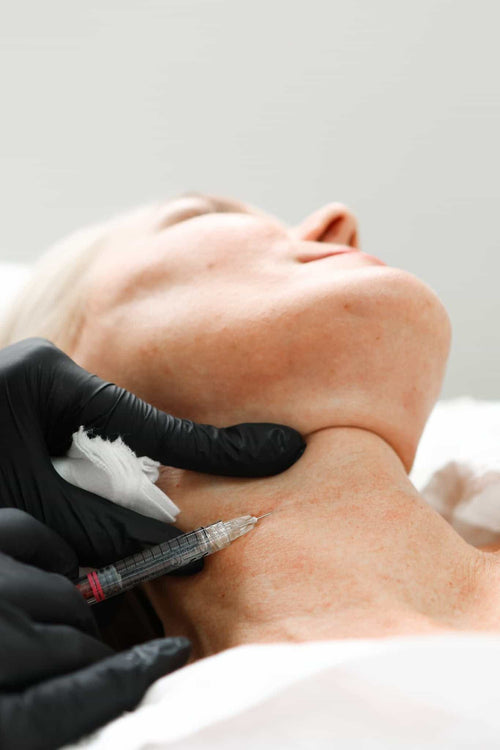Reserve Your Dermal Filler Appointment with Dr. Laura Geige Now
What Are Lip Fillers?
Composition and Administration
Lip fillers are dermal injections designed to enhance lip volume, shape, and definition. They are made from various injectable substances that plump up the lips by attracting and holding water molecules.
The most common type of lip filler is hyaluronic acid (HA), a natural substance found in the body that provides hydration and support to skin tissues. HA fillers are biocompatible, meaning they are well-tolerated by the body and degrade naturally over time.
Other types of lip fillers include: collagen, which is another natural protein found in connective tissue; poly-L-lactic acid (PLLA), a synthetic material that stimulates collagen production; and fat grafting, where the patient’s own fat is injected into the lips.
Lip filler administration typically involves injecting small amounts of the chosen substance directly into the desired areas of the lips. The procedure is usually performed by a qualified medical professional, such as a dermatologist, plastic surgeon, or licensed nurse injector.
Prior to the treatment, the provider will cleanse and numb the injection sites with a local anesthetic to ensure patient comfort.
Using fine needles, they carefully inject the filler into specific layers of the lips, tailoring the placement and amount based on the individual’s desired outcome and anatomy.
The entire procedure can take anywhere from 15 to 30 minutes, depending on the extent of the treatment.
Following the injection, the lips may be slightly swollen or tender for a few days, but this typically subsides within a week.
Results from lip fillers are immediate and gradually evolve over time as the filler integrates with the surrounding tissues.
The duration of results varies depending on the type of filler used and individual factors, but generally last between 6 months to 2 years.
How Long Do Lip Fillers Last?
Lip fillers are a cosmetic treatment that enhances the appearance and shape of the lips.
They involve injecting a gel-like substance, typically hyaluronic acid (HA), into the lip tissue.
Hyaluronic acid is a naturally occurring substance in the body that helps to retain moisture and add volume.
Lip fillers can be used to:
- Increase lip size and fullness
- Define and enhance the shape of the lips
- Smooth out wrinkles and lines around the mouth
- Create a more youthful appearance
The duration of lip filler results varies depending on several factors, including:
- Type of filler used: Different fillers have varying lifespans.
- Individual metabolism and skin type
- Lifestyle habits, such as sun exposure and smoking
- Number of syringes used during the treatment
Reserve a Dermal Filler Consultation with Dr. Laura Geige Now
Generally, lip fillers last anywhere from 6 to 18 months.
Some fillers may even last up to two years.
As the filler gradually breaks down over time, lip volume will diminish.
To maintain the desired results, repeat treatments are typically recommended every 6-12 months.
Potential Risks and Side Effects
Common Concerns
Lip fillers are a popular cosmetic procedure that involves injecting hyaluronic acid (HA) into the lips to increase their size, shape, and volume.
While lip fillers can offer attractive results, it’s crucial to be aware of potential risks and side effects.
Potential Risks and Side Effects:
Like any medical procedure, lip fillers carry some inherent risks. These can range from mild and temporary to more serious and long-lasting.
• **Bruising, Swelling, and Redness:** These are common side effects that typically resolve within a few days or weeks.
• **Pain and Discomfort:** Some people experience mild pain or discomfort during and after the procedure. This can usually be managed with over-the-counter pain relievers.
• **Lumps and Bumps:** Uneven filler distribution can result in lumps or bumps under the skin, which may require further treatment.
• **Infection:** There is a small risk of infection at the injection site. Proper hygiene practices and sterile techniques during the procedure help minimize this risk.
• **Allergic Reaction:** Although rare, some individuals may experience an allergic reaction to hyaluronic acid filler. This can range from mild itching or redness to severe anaphylaxis.
• **Vascular Occlusion (Filler Embolization):** This is a serious complication that occurs when filler is injected into a blood vessel, blocking blood flow to the tissues. It can lead to tissue damage and loss of function. Prompt medical attention is crucial if this occurs.

• **Asymmetry:** If filler is not evenly distributed, it can result in an asymmetrical appearance.
• **Migraines:** In some cases, lip fillers have been linked to migraines or headaches.
• **Changes in Lip Sensation:** Temporary numbness or tingling around the lips may occur due to nerve compression.
Common Concerns:
Many people have concerns about the potential risks and long-term effects of lip fillers.
• **Dissolving Time Frame:** Hyaluronic acid fillers are not permanent and will gradually dissolve over time, typically within 6 to 18 months.
• **Results Duration:** The length of time results last can vary depending on factors such as the type and amount of filler used, individual metabolism, and lifestyle.
• •
**Touch-up Appointments:** Regular touch-up appointments are necessary to maintain desired results.
• **Natural Look:** Choosing a skilled and experienced injector is essential to achieve natural-looking results. Overfilling can lead to an unnatural or “duck lip” appearance.
• **Cost and Maintenance:** Lip fillers require ongoing maintenance, which can be costly.
It’s important to consult with a qualified and reputable plastic surgeon or dermatologist who specializes in injectables to discuss your individual needs, expectations, and any potential risks associated with lip fillers.
Addressing Complications
Lip fillers are a popular cosmetic treatment that can enhance lip shape, size, and volume. However, like any medical procedure, there are potential risks and side effects associated with lip filler injections.
Here are some of the potential risks and side effects of lip filler injections:
-
Bruising and Swelling:
-
Infection:
-
Allergic Reactions:
-
Asymmetry:
-
Lumps and Nodules:
-
Vascular Occlusion:
These are common side effects that usually subside within a few days to a week. Cold compresses can help minimize bruising.
As with any injection, there is a risk of infection. Proper sterilization techniques and hygiene practices by the practitioner are essential to minimize this risk.
Some individuals may be allergic to the filler material. Allergic reactions can range from mild (redness, itching) to severe (anaphylaxis).
If the filler is not evenly distributed, it can result in an asymmetrical appearance.
These can occur if the filler is not properly injected or if the body reacts to the filler material.
This is a serious complication that occurs when the filler blocks blood flow to tissues. It requires immediate medical attention.
It’s important to choose a qualified and experienced practitioner who uses safe and FDA-approved fillers. Discuss your medical history, any allergies you have, and your desired outcome with the practitioner before undergoing lip filler injections.
Get Started with Your Dermal Filler Consultation with Dr. Laura Geige
Derwen Roots Mind Plus Motion Audrey’s JL Line the Studio
- Best CBD Infused Gummy Edibles For Winding Down After A Long Day - April 17, 2025
- Why THC Beverages Are Gaining Popularity Among Millennials - April 12, 2025
- Traptox Aka Trapezius Botox Treatment Near Windlesham, Surrey - January 2, 2025
